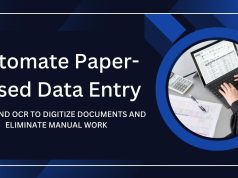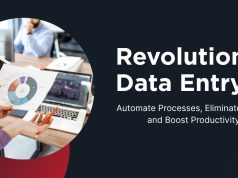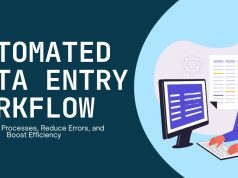Automating data entry from Excel to web platforms reduces errors, saves time, and boosts efficiency, allowing employees to focus on higher-value, strategic work.
Copying and pasting data from Excel spreadsheets into web forms feels like digital torture. One misplaced cell, one accidental keystroke, and hours of work vanish into the ether of human error. Yet millions of professionals perform this soul-crushing routine daily, manually transferring customer information, inventory data, and financial records from their trusty spreadsheets to various web platforms.
The repetitive nature of manual data entry doesn’t just drain productivity—it introduces costly mistakes that compound over time. A single transposed digit in a customer order can trigger shipping delays, billing disputes, and damaged relationships. Meanwhile, your team spends valuable hours on mindless copy-paste tasks instead of strategic work that actually moves your business forward.
Fortunately, the technology to automate data entry from Excel to web applications has matured dramatically. Modern automation tools can eliminate these tedious processes entirely, freeing your team to focus on higher-value activities while dramatically reducing errors. This shift isn’t just about convenience—it’s about fundamentally transforming how your business operates.
The Hidden Costs of Manual Data Entry
Manual data entry carries expenses that extend far beyond the obvious time investment. Research consistently shows that humans make errors in approximately 1% of all data entry tasks, which might sound minimal until you consider the volume of information most businesses process daily.

Error Multiplication
When incorrect data enters your system, it doesn’t stay contained. That single mistake propagates through reports, customer communications, and decision-making processes. A wrong price in your inventory system affects sales projections, procurement decisions, and customer satisfaction scores. These cascading effects can take weeks to identify and correct.
Opportunity Cost
Every hour your skilled employees spend copying data represents lost opportunities for strategic thinking, customer relationship building, or process improvement. If you pay a team member $25 per hour to perform data entry tasks, you’re essentially paying premium wages for work that automation can handle for pennies.
Mental Fatigue Impact
Repetitive data entry creates cognitive fatigue that affects overall job performance. Employees forced into these mundane tasks often experience decreased motivation and higher turnover rates. The mental energy required to maintain accuracy during repetitive tasks leaves less capacity for creative problem-solving and strategic thinking.
Understanding Automation Technologies
Several technologies can automate data entry from Excel to web platforms, each with distinct advantages and use cases. Understanding these options helps you choose the right solution for your specific needs.
Robotic Process Automation (RPA)
RPA tools like UiPath, Blue Prism, and Automation Anywhere create software robots that mimic human interactions with web interfaces. These bots can read Excel files, navigate web forms, and input data exactly as a human would—but with perfect accuracy and tireless consistency. RPA works particularly well for standardized processes with predictable web interfaces. Learn more in our guide to RPA and automated data entry workflows.
API Integration
Many modern web platforms offer Application Programming Interfaces (APIs) that allow direct data exchange. When both your Excel data and target web platform support API connections, this approach provides the most reliable and fastest automation method. APIs eliminate the need to interact with user interfaces entirely, transferring data directly between systems.
Custom Scripts and Macros
Programming languages like Python, along with Excel’s built-in VBA capabilities, can create custom automation solutions. These approaches require more technical expertise but offer maximum flexibility for unique requirements. Python libraries like Selenium can automate web browser interactions, while pandas excels at Excel data manipulation. Check out our guide on Python data entry automation for a detailed walkthrough.
Third-Party Integration Platforms
Services like Zapier, Microsoft Power Automate, and Integromat provide user-friendly interfaces for connecting Excel with web applications. These platforms offer pre-built connectors for popular software combinations, making automation accessible to non-technical users.

Benefits Beyond Time Savings
While eliminating manual data entry obviously saves time, the broader benefits often prove more valuable to business operations.
Accuracy Improvements
Automated systems achieve near-perfect accuracy rates, typically above 99.9%. This precision eliminates the costs associated with error correction, customer complaints, and process delays. More importantly, reliable data enables better decision-making across your organization. Discover how automated CRM data entry improves accuracy and efficiency.
Scalability Advantages
Manual processes become bottlenecks as your business grows. Adding more data entry staff increases costs linearly with volume. Automation scales effortlessly—the same system that processes 100 records daily can handle 10,000 with minimal additional resources.
Compliance and Audit Trails
Automated systems create detailed logs of every data transfer, timestamp, and modification. This audit trail proves invaluable for regulatory compliance, quality assurance, and troubleshooting. Manual processes rarely provide such comprehensive documentation.
Real-Time Processing
Automation enables real-time or near-real-time data synchronization between Excel and web platforms. This immediacy improves customer service, inventory management, and financial reporting accuracy. Instead of daily or weekly batch updates, your systems stay constantly synchronized. Learn how web data entry automation can provide instant updates.
Implementation Strategies
Successfully implementing data entry automation requires careful planning and execution. The most effective approaches follow a structured methodology that minimizes disruption while maximizing benefits.
Start with Process Mapping
Document your current data entry processes in detail before implementing automation. Identify data sources, transformation requirements, validation rules, and error handling procedures. This mapping reveals optimization opportunities and helps select appropriate automation technologies.
Pilot Program Approach
Begin with a single, well-defined process rather than attempting organization-wide automation immediately. Choose a process with clear inputs and outputs, minimal exceptions, and measurable success criteria. Success with the pilot builds confidence and provides lessons for broader implementation.
Data Quality Preparation
Automation amplifies existing data quality issues. Clean your Excel data sources before implementing automation—standardize formats, eliminate duplicates, and establish validation rules. Poor input data will produce poor automated results, regardless of the technology used. Learn more in our guide to automating data entry Excel to web.
User Training and Change Management
Automation changes job roles and responsibilities significantly. Provide comprehensive training not just on new tools, but on how workflows will change. Address concerns about job security by emphasizing how automation enables employees to focus on higher-value activities. For inspiration, see the evolution of programmatic advertising and how adoption transformed roles in marketing teams.

Choosing the Right Solution
Selecting appropriate automation technology depends on several factors specific to your organization and use cases.
Technical Complexity Assessment
Evaluate your team’s technical capabilities honestly. API integrations offer superior performance but require programming skills. RPA tools provide middle-ground solutions with visual interfaces but still need technical understanding. Integration platforms offer the easiest implementation but may lack flexibility for complex requirements.
Volume and Frequency Considerations
High-volume, frequent data transfers justify more sophisticated and expensive automation solutions. Low-volume, occasional transfers might work fine with simpler tools or even enhanced Excel macros. Calculate the break-even point where automation costs less than manual processing.
Integration Requirements
Consider how many different web platforms you need to connect with Excel. Solutions that handle multiple integrations efficiently may cost more upfront but provide better long-term value than multiple single-purpose tools.
Security and Compliance Needs
Heavily regulated industries require automation solutions with robust security features, audit capabilities, and compliance certifications. These requirements may eliminate some options while making others more attractive despite higher costs.
Measuring Success and ROI
Quantifying automation benefits ensures continued support and identifies improvement opportunities.
Time Savings Calculation
Track hours saved by eliminating manual data entry tasks. Multiply saved hours by employee hourly rates to calculate direct cost savings. Don’t forget to include the value of reallocating employees to higher-value activities.
Error Reduction Metrics
Measure accuracy improvements by comparing error rates before and after automation. Calculate the cost of errors in terms of correction time, customer impact, and opportunity loss. These “soft” savings often exceed direct time savings.
Process Efficiency Gains
Monitor improvements in process cycle times, customer satisfaction scores, and data freshness. Automation often delivers benefits beyond simple task elimination, improving overall business performance.
Integration With Other Business Systems
Data entry automation doesn’t need to exist in isolation. By integrating Excel data with CRM, ERP, accounting, and inventory systems, organizations can create seamless, end-to-end workflows. For instance, updating product stock in Excel could automatically reflect in your e-commerce platform, inventory system, and internal reporting dashboards. This connectivity ensures that all departments operate on the same accurate data, eliminating inconsistencies, improving decision-making, and reducing the need for manual reconciliation. Integration also allows for real-time reporting, providing leadership with timely insights into operations and performance metrics.
Data Validation and Error Prevention
Even the most sophisticated automation cannot fix poor-quality input data. A critical step before implementing automation is building robust data validation rules. These rules ensure that all entries meet predefined criteria, such as correct formats, required fields, and logical constraints. Automated error detection can flag anomalies for human review, preventing faulty data from entering key systems. Over time, this reduces the need for corrections and ensures that business intelligence, reporting, and decision-making rely on accurate, trustworthy data.
Monitoring and Maintenance of Automation Systems
Automation is not a “set and forget” solution. Continuous monitoring is essential to ensure that workflows remain effective and aligned with evolving business processes. Scheduled audits, automated error reporting, and dashboards showing real-time performance help identify potential bottlenecks or failures quickly. Additionally, maintaining documentation and change logs ensures that teams can troubleshoot issues or update workflows when Excel templates, web forms, or software platforms change. A proactive approach to maintenance minimizes downtime and keeps automated processes running smoothly.
Change Management and Employee Adoption
Automation can transform job roles, shifting employees from repetitive tasks to strategic or creative work. However, introducing automation without proper change management can lead to resistance or anxiety among staff. Providing training, demonstrating the benefits of automation, and involving employees in process redesign encourages adoption and smooths transitions. Highlighting how automation frees employees from mundane tasks to focus on problem-solving or customer engagement can foster a culture of continuous improvement and innovation.
Transforming Your Business Operations
Automating data entry from Excel to web platforms represents more than a simple efficiency improvement—it fundamentally changes how your organization operates. Teams freed from repetitive tasks can focus on strategic initiatives, customer relationships, and process innovations that drive competitive advantage.
The technology exists today to eliminate virtually all manual data entry tasks. The question isn’t whether automation is possible, but rather how quickly you can implement it effectively. Start with a clear assessment of your current processes, choose appropriate technology for your needs, and implement gradually to ensure success.
Your future self will thank you for taking action now. Every day spent on manual data entry is a day that could be invested in growing your business and empowering your team to reach their full potential. Explore more on how to automate data entry and reclaim your time.
Frequently Asked Questions (FAQ)
How long does it take to implement data entry automation?
Implementation timelines vary widely based on complexity and chosen technology. Simple integrations using platforms like Zapier can be operational within days, while comprehensive RPA implementations may require several months. Most organizations see initial results within 2-8 weeks.
What happens when web interfaces change?
Interface changes can disrupt automation, particularly with RPA solutions that interact with user interfaces. API-based integrations are more resilient to cosmetic changes. Build monitoring and alerting into your automation to detect failures quickly. Maintain relationships with software vendors to receive advance notice of significant interface changes.
Can automation handle exceptions and edge cases?
Modern automation tools can handle many exceptions through conditional logic and error handling routines. However, truly complex decision-making still requires human intervention. Design your automation to flag unusual cases for manual review rather than attempting to automate every possible scenario.
Is automation secure for sensitive data?
Properly implemented automation can be more secure than manual processes. Automated systems eliminate the risk of human error in handling sensitive information and provide detailed audit trails. Choose automation solutions with appropriate security certifications for your industry and implement proper access controls.
How much does automation cost?
Costs vary dramatically based on solution complexity and scale. Basic integration platforms start around $20-50 per month per user. Enterprise RPA solutions can cost thousands monthly but handle much more complex processes. Calculate ROI based on your specific volume and labor costs to determine budget requirements.
What if our Excel data format changes frequently?
Frequent format changes make automation more challenging but not impossible. Build flexibility into your automation by using dynamic field mapping, data validation rules, and standardized templates. Consider implementing data governance practices to minimize unnecessary format variations.
What security measures should be considered?
Ensure that automation platforms comply with industry security standards, encrypt sensitive data, implement role-based access, and maintain detailed audit logs for compliance purposes.
How scalable is automation for growing businesses?
Automation scales effortlessly. Unlike manual processes that require adding more staff for increased volume, automated workflows can handle thousands of records with minimal additional resources.
What is the ROI of Excel-to-web automation?
ROI can be calculated by combining time saved, error reduction, improved data quality, employee productivity gains, and indirect benefits such as better customer service and faster reporting.










